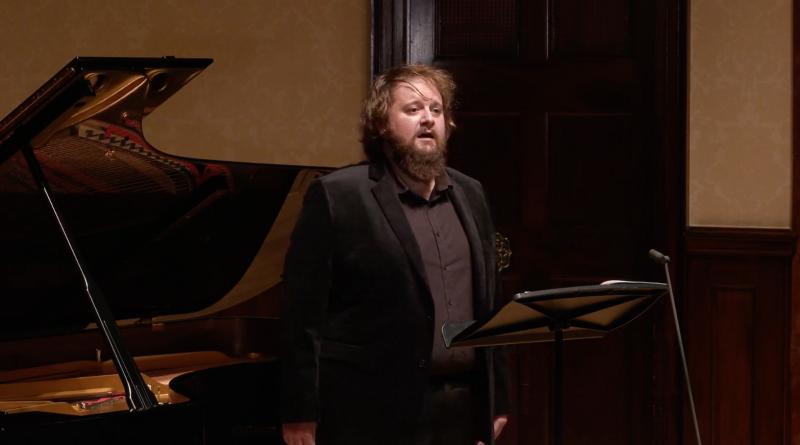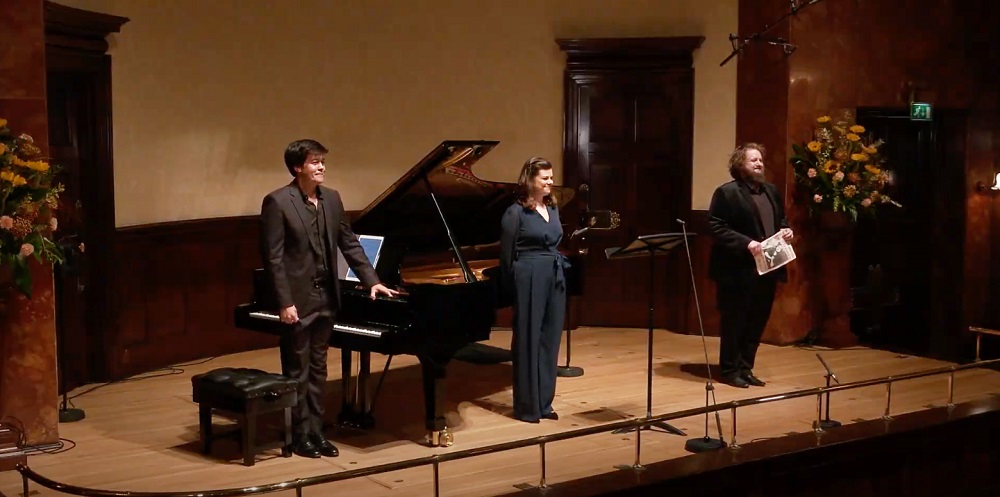Allan Clayton, Stephanie Wake-Edwards, James Baillieu, Wigmore Hall review - consummate musicality and technique | reviews, news & interviews
Allan Clayton, Stephanie Wake-Edwards, James Baillieu, Wigmore Hall review - consummate musicality and technique
Allan Clayton, Stephanie Wake-Edwards, James Baillieu, Wigmore Hall review - consummate musicality and technique
John Donne's poetry was the connecting thread through a soberly beautiful recital

Last seen gurning and camping his way across the Royal Opera House stage in absurdist musical fantasy Frankenstein!!, it was a very different Allan Clayton who held the Wigmore Hall in stillness just a few nights later.
We’ve seen a lot of the tenor at operatic extremes recently, walking a tense tightrope of drama and music in Brett Dean’s Hamlet, gamely flinging himself into the challenges of Gerald Barry, HK Gruber or Offenbach, and it’s good to hear that, when all else is stripped away, the voice is still as lovely as ever – and perhaps even more interesting, bringing back something of those musical adventures to the concert hall.
The programme was a sober one. Britten’s Holy Sonnets of John Donne don’t ease up in their musical questions, uncertainties and confrontations until two-thirds of the way through the cycle. From the insistent tolling that opens the piano part through the restless assault of “Batter my heart” and the drooping bitterness of “O might those sighs”, Clayton and pianist James Baillieu kept us edgy and unsettled as they wrestled with these inscrutable settings.  But “Since she whom I lov’d” finds transfiguring sensuality in death, and suddenly the cycle opens to new colours, new softness. It was a moment perfectly judged by Clayton, who leant into the consonance, resting for a moment on Baillieu’s lulling accompaniment – a pause before the final musical ascent to that shattering closing phrase, “Death, thou shalt die”. Nearby graveyards must have trembled.
But “Since she whom I lov’d” finds transfiguring sensuality in death, and suddenly the cycle opens to new colours, new softness. It was a moment perfectly judged by Clayton, who leant into the consonance, resting for a moment on Baillieu’s lulling accompaniment – a pause before the final musical ascent to that shattering closing phrase, “Death, thou shalt die”. Nearby graveyards must have trembled.
A fascinating satellite to the Britten, picking up where the unaccompanied final line of Sonnet VII leaves off, was South-African composer Priaulx Rainier’s Cycle for Declamation. Set for solo voice, no piano accompaniment, these Donne settings are absolutely exposed – thoughts happening out loud without musical mediation. There’s an honesty to Clayton’s delivery that thrives on this kind of exposure, you could hear him relishing the freedom in the actorly control of pace and weighting.
Before these 20th-century works we went back to where it all began – to Purcell’s contemporaries William Croft, Jeremiah Clarke and Pelham Humfrey. It’s here you can really measure just how far Clayton’s voice has come from his Oxbridge choral scholar beginnings. Heavier now, Peter Grimes in its sights and Wagner beyond, it’s a bigger instrument to manoeuvre around the filigree semiquaver passages. What’s lost in featherweight agility is gained in the range of colour and the sweetness of a head-voice croon that’s all the more effective for being so unexpected. Add this to the musicality of the phrasing, the care over text, the balance of purity and husk on any given note and you have an exceptional singer whose future prospects seem limitless.  Barbara Hannigan’s Momentum scheme for young artists saw Ferrier Award finalist mezzo Stephanie Wake-Edwards (pictured above with Baillieu and Clayton) stepping in mid-programme for a brief performance. Songs by Brahms, Mahler and Frank Bridge felt out of place – an interlude rather than an integrated part of the recital itself – showcasing a beautiful, velvety voice but giving little opportunity for the singer to relax into performance rather than audition mode. An encore – Britten’s arrangement of Greensleeves performed with Clayton – was the best thing by far: a proper musical dialogue and moment of connection.
Barbara Hannigan’s Momentum scheme for young artists saw Ferrier Award finalist mezzo Stephanie Wake-Edwards (pictured above with Baillieu and Clayton) stepping in mid-programme for a brief performance. Songs by Brahms, Mahler and Frank Bridge felt out of place – an interlude rather than an integrated part of the recital itself – showcasing a beautiful, velvety voice but giving little opportunity for the singer to relax into performance rather than audition mode. An encore – Britten’s arrangement of Greensleeves performed with Clayton – was the best thing by far: a proper musical dialogue and moment of connection.
rating
Explore topics
Share this article
The future of Arts Journalism
You can stop theartsdesk.com closing!
We urgently need financing to survive. Our fundraising drive has thus far raised £49,000 but we need to reach £100,000 or we will be forced to close. Please contribute here: https://gofund.me/c3f6033d
And if you can forward this information to anyone who might assist, we’d be grateful.

Subscribe to theartsdesk.com
Thank you for continuing to read our work on theartsdesk.com. For unlimited access to every article in its entirety, including our archive of more than 15,000 pieces, we're asking for £5 per month or £40 per year. We feel it's a very good deal, and hope you do too.
To take a subscription now simply click here.
And if you're looking for that extra gift for a friend or family member, why not treat them to a theartsdesk.com gift subscription?
more Classical music
 Kilsby, Parkes, Sinfonia of London, Wilson, Barbican review - string things zing and sing in expert hands
British masterpieces for strings plus other-worldly tenor and horn - and a muscular rarity
Kilsby, Parkes, Sinfonia of London, Wilson, Barbican review - string things zing and sing in expert hands
British masterpieces for strings plus other-worldly tenor and horn - and a muscular rarity
 From Historical to Hip-Hop, Classically Black Music Festival, Kings Place review - a cluster of impressive stars for the future
From quasi-Mozartian elegance to the gritty humour of a kitchen inspection
From Historical to Hip-Hop, Classically Black Music Festival, Kings Place review - a cluster of impressive stars for the future
From quasi-Mozartian elegance to the gritty humour of a kitchen inspection
 Shibe, LSO, Adès, Barbican review - gaudy and glorious new music alongside serene Sibelius
Adès’s passion makes persuasive case for the music he loves, both new and old
Shibe, LSO, Adès, Barbican review - gaudy and glorious new music alongside serene Sibelius
Adès’s passion makes persuasive case for the music he loves, both new and old
 Anja Mittermüller, Richard Fu, Wigmore Hall review - a glorious hall debut
The Austrian mezzo shines - at the age of 22
Anja Mittermüller, Richard Fu, Wigmore Hall review - a glorious hall debut
The Austrian mezzo shines - at the age of 22
 First Person: clarinettist Oliver Pashley on the new horizons of The Hermes Experiment's latest album
Compositions by members of this unusual quartet feature for the first time
First Person: clarinettist Oliver Pashley on the new horizons of The Hermes Experiment's latest album
Compositions by members of this unusual quartet feature for the first time
 Gesualdo Passione, Les Arts Florissants, Amala Dior Company, Barbican review - inspired collaboration excavates the music's humanity
At times it was like watching an anarchic religious procession
Gesualdo Passione, Les Arts Florissants, Amala Dior Company, Barbican review - inspired collaboration excavates the music's humanity
At times it was like watching an anarchic religious procession
 Classical CDs: Camels, concrete and cabaret
An influential American composer's 90th birthday box, plus British piano concertos and a father-and-son duo
Classical CDs: Camels, concrete and cabaret
An influential American composer's 90th birthday box, plus British piano concertos and a father-and-son duo
 Cockerham, Manchester Camerata, Sheen, Martin Harris Centre, Manchester review - re-enacting the dawn of modernism
Two UK premieres added to three miniatures from a seminal event of January 1914
Cockerham, Manchester Camerata, Sheen, Martin Harris Centre, Manchester review - re-enacting the dawn of modernism
Two UK premieres added to three miniatures from a seminal event of January 1914
 Kempf, Brno Philharmonic, Davies, Bridgewater Hall, Manchester review - European tradition meets American jazz
Bouncing Czechs enjoy their Gershwin and Brubeck alongside Janáček and Dvořák
Kempf, Brno Philharmonic, Davies, Bridgewater Hall, Manchester review - European tradition meets American jazz
Bouncing Czechs enjoy their Gershwin and Brubeck alongside Janáček and Dvořák
 Solomon, OAE, Butt, QEH review - daft Biblical whitewashing with great choruses
Even a top soprano and mezzo can’t make this Handel paean wholly convincing
Solomon, OAE, Butt, QEH review - daft Biblical whitewashing with great choruses
Even a top soprano and mezzo can’t make this Handel paean wholly convincing
 Two-Piano Gala, Kings Place review - shining constellations
London Piano Festival curators and illustrious friends entertain and enlighten
Two-Piano Gala, Kings Place review - shining constellations
London Piano Festival curators and illustrious friends entertain and enlighten
 Echo Vocal Ensemble, Latto, Union Chapel review - eclectic choral programme garlanded with dance
Beautiful singing at the heart of an imaginative and stylistically varied concert
Echo Vocal Ensemble, Latto, Union Chapel review - eclectic choral programme garlanded with dance
Beautiful singing at the heart of an imaginative and stylistically varied concert

Add comment